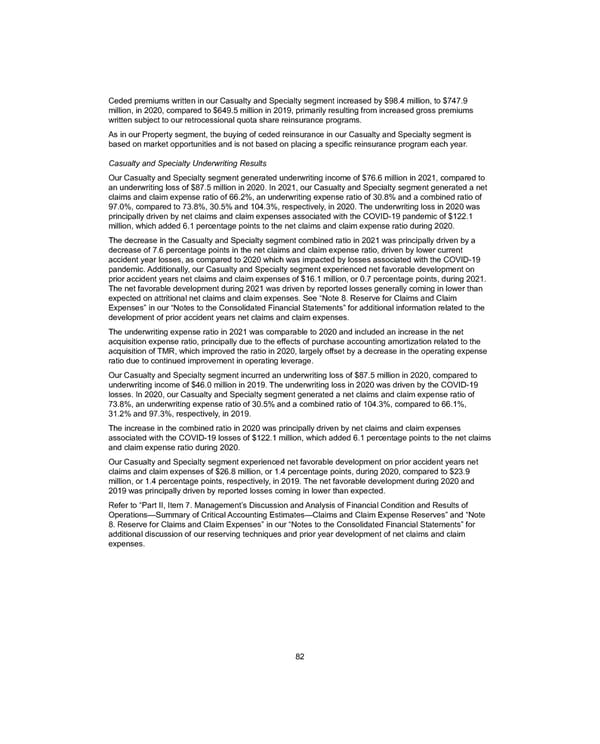Ceded premiums written in our Casualty and Specialty segment increased by $98.4 million, to $747.9 million, in 2020, compared to $649.5 million in 2019, primarily resulting from increased gross premiums written subject to our retrocessional quota share reinsurance programs. As in our Property segment, the buying of ceded reinsurance in our Casualty and Specialty segment is based on market opportunities and is not based on placing a specific reinsurance program each year. Casualty and Specialty Underwriting Results Our Casualty and Specialty segment generated underwriting income of $76.6 million in 2021, compared to an underwriting loss of $87.5 million in 2020. In 2021, our Casualty and Specialty segment generated a net claims and claim expense ratio of 66.2%, an underwriting expense ratio of 30.8% and a combined ratio of 97.0%, compared to 73.8%, 30.5% and 104.3%, respectively, in 2020. The underwriting loss in 2020 was principally driven by net claims and claim expenses associated with the COVID-19 pandemic of $122.1 million, which added 6.1 percentage points to the net claims and claim expense ratio during 2020. The decrease in the Casualty and Specialty segment combined ratio in 2021 was principally driven by a decrease of 7.6 percentage points in the net claims and claim expense ratio, driven by lower current accident year losses, as compared to 2020 which was impacted by losses associated with the COVID-19 pandemic. Additionally, our Casualty and Specialty segment experienced net favorable development on prior accident years net claims and claim expenses of $16.1 million, or 0.7 percentage points, during 2021. The net favorable development during 2021 was driven by reported losses generally coming in lower than expected on attritional net claims and claim expenses. See “Note 8. Reserve for Claims and Claim Expenses” in our “Notes to the Consolidated Financial Statements” for additional information related to the development of prior accident years net claims and claim expenses. The underwriting expense ratio in 2021 was comparable to 2020 and included an increase in the net acquisition expense ratio, principally due to the effects of purchase accounting amortization related to the acquisition of TMR, which improved the ratio in 2020, largely offset by a decrease in the operating expense ratio due to continued improvement in operating leverage. Our Casualty and Specialty segment incurred an underwriting loss of $87.5 million in 2020, compared to underwriting income of $46.0 million in 2019. The underwriting loss in 2020 was driven by the COVID-19 losses. In 2020, our Casualty and Specialty segment generated a net claims and claim expense ratio of 73.8%, an underwriting expense ratio of 30.5% and a combined ratio of 104.3%, compared to 66.1%, 31.2% and 97.3%, respectively, in 2019. The increase in the combined ratio in 2020 was principally driven by net claims and claim expenses associated with the COVID-19 losses of $122.1 million, which added 6.1 percentage points to the net claims and claim expense ratio during 2020. Our Casualty and Specialty segment experienced net favorable development on prior accident years net claims and claim expenses of $26.8 million, or 1.4 percentage points, during 2020, compared to $23.9 million, or 1.4 percentage points, respectively, in 2019. The net favorable development during 2020 and 2019 was principally driven by reported losses coming in lower than expected. Refer to “Part II, Item 7. Management’s Discussion and Analysis of Financial Condition and Results of Operations—Summary of Critical Accounting Estimates—Claims and Claim Expense Reserves” and “Note 8. Reserve for Claims and Claim Expenses” in our “Notes to the Consolidated Financial Statements” for additional discussion of our reserving techniques and prior year development of net claims and claim expenses. 82
 2021 Annual Report Page 97 Page 99
2021 Annual Report Page 97 Page 99